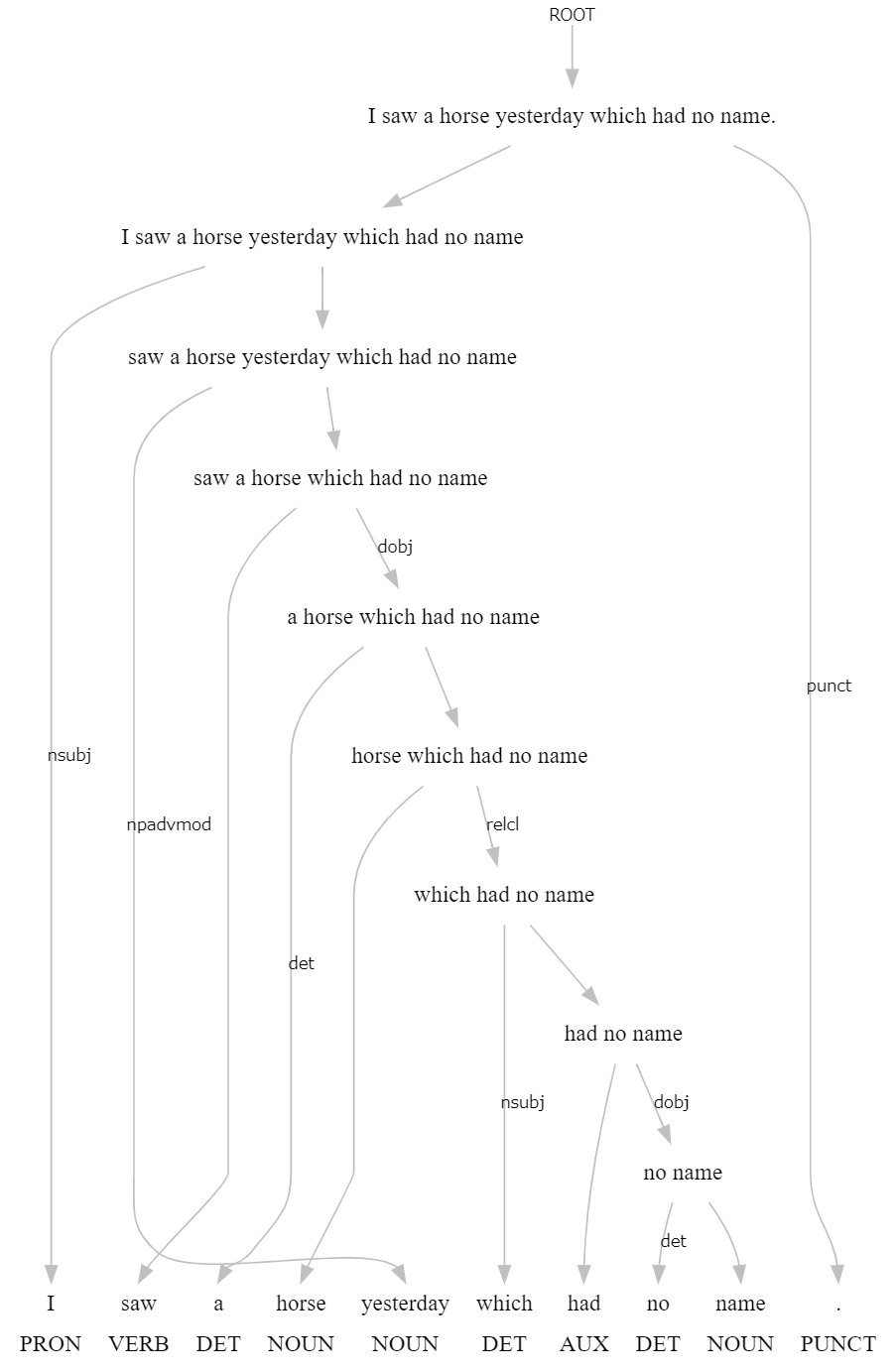Simple dependency visualizer for spaCy, UniDic2UD, Stanza, NLP-Cube, Trankit, etc.
>>> import spacy
>>> nlp=spacy.load("en_core_web_sm")
>>> doc=nlp("I saw a horse yesterday which had no name.")
>>> import deplacy
>>> deplacy.render(doc)
I PRON <══════════════╗ nsubj
saw VERB ═══════════╗═╗═╝═╗ ROOT
a DET <════════╗ ║ ║ ║ det
horse NOUN ═══════╗═╝<╝ ║ ║ dobj
yesterday NOUN <══════║═════╝ ║ npadvmod
which DET <════╗ ║ ║ nsubj
had AUX ═══╗═╝<╝ ║ relcl
no DET <╗ ║ ║ det
name NOUN ═╝<╝ ║ dobj
. PUNCT <════════════════╝ punctdeplacy.render(doc,BoxDrawingWidth=1,EnableCR=False,WordRight=False,CatenaAnalysis=True,file=None,Japanese=False) renders doc on a terminal. For old terminals, whose Box Drawing characters are "fullwidth", BoxDrawingWidth=2 nicely works. For several languages with "proportional" characters, EnableCR=True or WordRight=True may work well. CatenaAnalysis=False disables Immediate Catena Analysis.
deplacy.serve(doc,port=5000,RtoL=False) invokes a simple web-server to visualize doc with SVG. Try to connect http://127.0.0.1:5000 with your local browser. For Google Colaboratory, port=None visualizes doc directly on the notebook.
deplacy.dot(doc,RtoL=False) returns raw DOT string for graphviz.Source.
- Afrikaans
- アイヌイタㇰ
- العربية
- Беларуская
- Български
- Català
- ⲙⲉⲧⲣⲉⲙⲛⲭⲏⲙⲓ
- Čeština
- Cymraeg
- Dansk
- Deutsch
- Ελληνικά
- English
- Español
- Eesti
- Euskara
- فارسی
- Suomi
- Føroyskt
- Français
- Gaeilge
- Gàidhlig
- Galego
- Ἑλληνική
- עברית
- हिन्दी
- Hrvatski
- Magyar
- Հայերեն
- Bahasa Indonesia
- Íslenska
- Italiano
- 日本語
- Қазақша
- 한국어
- Latina
- Lietuvių
- Latviešu
- 漢文/文言文
- Македонски
- Malti
- Norsk(bokmål)
- Nederlands
- Nynorsk
- Polski
- Português
- Română
- Русский
- Slovenčina
- Slovenščina
- Српски
- Srpski
- Svenska
- தமிழ்
- ไทย
- Tagalog
- Türkçe
- Українська
- Tiếng Việt
- Wolof
- 中文(简体)
- 中文(繁體)
pip install deplacyYou need to install spaCy, UniDic2UD, Stanza, NLP-Cube, or Trankit separately. For Google Colaboratories, please follow (and edit) the templates shown below.
- Afrikaans
- アイヌイタㇰ
- العربية
- Беларуская
- Български
- Català
- ⲙⲉⲧⲣⲉⲙⲛⲭⲏⲙⲓ
- Čeština
- Cymraeg
- Dansk
- Deutsch
- Ελληνικά
- English
- Español
- Eesti
- Euskara
- فارسی
- Suomi
- Føroyskt
- Français
- Gaeilge
- Gàidhlig
- Galego
- Ἑλληνική
- עברית
- हिन्दी
- Hrvatski
- Magyar
- Հայերեն
- Bahasa Indonesia
- Íslenska
- Italiano
- 日本語
- Қазақша
- 한국어
- Latina
- Lietuvių
- Latviešu
- 漢文/文言文
- Македонски
- Malti
- Norsk(bokmål)
- Nederlands
- Nynorsk
- Polski
- Português
- Română
- Русский
- Slovenčina
- Slovenščina
- Српски
- Srpski
- Svenska
- தமிழ்
- ไทย
- Tagalog
- Türkçe
- Українська
- Tiếng Việt
- Wolof
- 中文(简体)
- 中文(繁體)
Koichi Yasuoka (安岡孝一)
- Koichi Yasuoka: deplacy: a CUI-based tree visualizer for Universal Dependencies, IPSJ Symposium Series, Vol.2020, No.1 (December 2020), pp.95-100.


